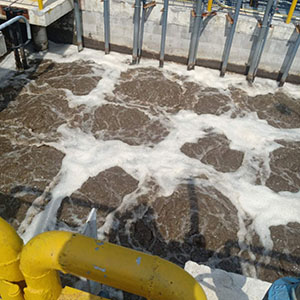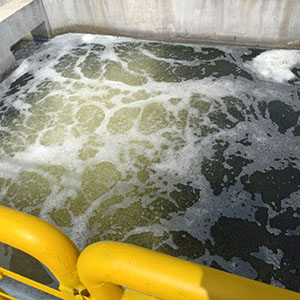
Home Products Sewage Treatment Bacteria Municipal Sewage Treatment Application of nitrifying bacteria in pe


1. Project Overview
There are two A/O sewage treatment systems on site, with an inlet flow of 150-20m3/h and A daily total inflow of 3000-4000m3, anoxic tank volume of 300 m3 and aerobic tank volume of 1000 m3, total salt of 30,000mg/L and ammonia nitrogen in and out of water of about 150mg/ L, with almost no removal rate of ammonia nitrogen. The nitrification system collapsed.
2. The project achieves its goals
The petrochemical project process is "A/O process +MBR+ ozone advanced oxidation +BAF+ high pressure reverse osmosis +MVR unit". The process design is complete. Due to the control of inlet water quality and site conditions, the removal rate of ammonia nitrogen in the aerobic pool basically does not exist. Now we plan to add nitrifying bacteria agent of our company to gradually restore the biochemical effect of the system.
Effluent ammonia nitrogen: ≦10mg/ L
3. Solutions
3.1 Composition and quality characteristics of sewage
3.1.1 Composition of sewage
The sewage of the project mainly includes: water produced by petrochemical process and water eluting chlorine wastewater, and the treated water is reused as circulating cooling water.
3.1.2 Water quality characteristics
The water quality characteristics of the petrochemical process are as follows: high salt, high hardness, high ammonia nitrogen, high COD and high salt content. After the softening treatment, the water enters the subsequent unit for in-depth treatment.
Water elution chlorine wastewater water quality characteristics: water quality is relatively good, low salt, low hardness, low COD.
3.2 Nitrifying bacteria agent addition scheme
3.2.1 Nitrifying bacteria agent on machine control conditions
Anoxic pool DO: 0.2-0.5mg/ L
Aerobic tank DO: 2-4mg/ L
Anoxic tank PH: 7-8
Aerobic tank PH: 7.5-8.5
Biochemical tank temperature: 20-30℃
3.2.2 On-site nitrifying bacteria agent addition
The nitrifying bacteria agent of our company is directly added to the inlet end of the aerobic pool, and the proportion of nitrifying bacteria can be rapidly increased by controlling the appropriate growth conditions of nitrifying bacteria, thus improving the ammonia nitrogen removal rate. The planned addition scheme is as follows:
(1) On the first day, 0.5‰ nitrifying bacteria was added to the aerobic tank to control the dissolved oxygen, pH, temperature and other conditions for culture.
(2) On the second day, 0.5‰ nitrifying bacteria was added to the aerobic tank to maintain an appropriate growth environment for nitrifying bacteria in the tank for culture.
(3) After the addition of nitrifying bacteria, water samples from the inlet end and outlet end of aerobic tank were taken every day to detect the change of ammonia nitrogen concentration and observe the operation effect of nitrifying bacteria addition.
After 2-4 weeks of addition, the ammonia nitrogen effluent from the aerobic tank was significantly reduced to less than 5mg/L, fully meeting the current production needs.
Name: Nicole Yu
Mobile:+86 17718148007
Tel:+86 17718148007
Whatsapp:8617718148007
Email:sales@kashionbiotech.com
Add:No.6, Zhanxi Road, Yaohai District, Hefei City, Anhui Province, China.